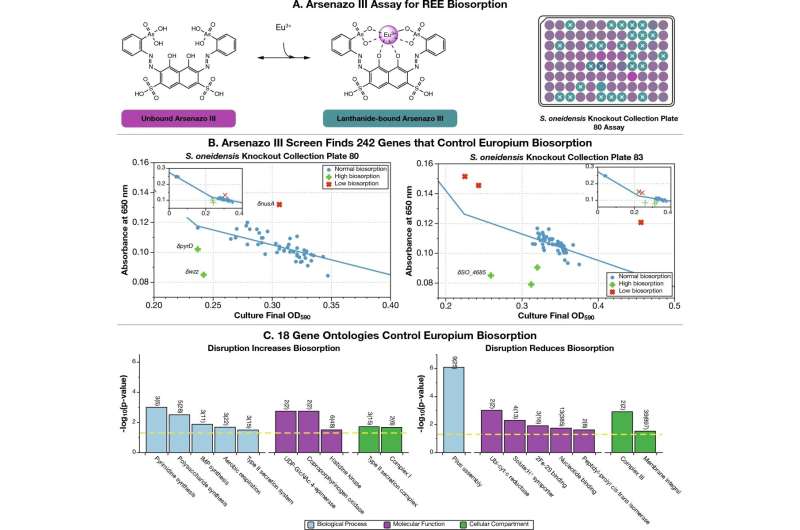This article has been reviewed according to Science X's editorial process and policies. Editors have highlighted the following attributes while ensuring the content's credibility:
fact-checked
peer-reviewed publication
trusted source
proofread
Metal-loving microbes offer a green way to refine rare earth elements

Rare earth elements are essential components of electric cars, wind turbines and smartphones. Retrieving these metals from raw ore requires processing with acids and solvents.
Now, Cornell scientists have characterized the genome of Shewanella oneidensis—a metal-loving bacteria with an affinity for rare earth elements—to replace the harsh chemical processing with a benign practice called biosorption.
Their research, "Genomic characterization of rare earth binding by Shewanella oneidensis," was published in Scientific Reports.
"The problem with the current methods of rare earth element purification is that they rely heavily on organic solvents and harsh chemicals," said senior author Buz Barstow, assistant professor of biological and environmental engineering in the College of Agriculture and Life Sciences. "These methods are costly and environmentally damaging. Here we have a green alternative that uses microbes to selectively adsorb and purify rare earth elements, eliminating the need for harmful chemicals. We're making the purification process greener."
The microbe selectively adsorbs—or clings—to these rare earth elements, making it an ideal candidate to carry out an eco-friendly purification procedure.
Generally, S. oneidensis prefers dining on the f-block elements residing in the sixth row of the periodic table, known as the lanthanides. Specifically, the microbe favors europium.
Characterizing the S. oneidensis's genome allows scientists to tweak its preference for processing the other rare earth elements.
The scientists screened 3,373 parts of the S. oneidensis genome and found 242 genes that influence it.
The mutant genes found in the bacteria by the scientists can reduce the length of that rare earth element purification process by almost one-third—compared with the wild variety of S. oneidensis—and offers a roadmap for honing this green method.
"Our work points to key genes that control membrane composition that are traditionally responsible for cell adhesion and biofilm formation in rare earth element biosorption," said lead author Sean Medin, a doctoral student in Barstow's lab and a founder of REEgen. "This work advances the mechanisms responsible for rare earth elements biosorption in S. oneidensis."
This work has the potential to make processing rare earths cleaner and scalable, Medin said. "Currently all the purification of rare earth elements is done abroad, due to stringent environmental regulations and high infrastructure costs of building a separations plant," he said. "Our process would make environmentally harmful solvents unnecessary."
"Our process potentially would be significantly less land- and capital-intensive to build," Medin said, "as our separations could be done with repeated enrichment through columns full of immobilized bacteria instead of mixer-settler plants that are miles long."
While the technology is still in development, the researchers are optimistic about potential impact. This technology could help develop a stable U.S. supply of rare earth elements for technology and defense applications, said Barstow, a faculty fellow at the Cornell Atkinson Center for Sustainability.
The group anticipates creating a pilot-scale purification system by 2028.
"This research gives us a genetic blueprint for making a microbe that lets allows us to purify rare earths in an environmentally friendly way," Barstow said. "If you want to reduce climate change, this allows us to build a sustainable energy infrastructure—things like improving electric vehicles, wind turbines, creating superconductors and offering high-efficiency lighting. That's the ultimate payoff."
More information: Sean Medin et al, Genomic characterization of rare earth binding by Shewanella oneidensis, Scientific Reports (2023). DOI: 10.1038/s41598-023-42742-6
Journal information: Scientific Reports
Provided by Cornell University




















